
Fluxes/Diarrhea and Related Illnesses Page Menu: 1 2 3 4 5 6 7 8 9 10 11 Next>>
Treating Fluxes in the Golden Age of Piracy, Page 10
Treatment of a Flux: Internal Medicines - Cockburn's Electuary
"THE Cures for a Diarrhœa that we meet with in Books of Physick, are very various in their Nature, but more various in their Nature; an Argument, that either Physicians have not hitherto discovered a proper Method of Cure, or sufficient Remedies for executing it. ...every Remedy comes equally and promiscuously recommended to us... One Medicine is equally our Choice as another; nothing besides our Fancy (a miserable Guide) is left to conduct us..." (William Cockburn, The Nature and Cure of Fluxes, p. 93-4)

Artist: Willem van de Velde the Younger
An English Sixth Rate Firing a Salute (1706)
As Cockburn suggests, the sheer type and variety of the medicines mentioned by the authors during this time hints at the inability of period medical men to find a reliable medicinal cure for fluxes. So Cockburn decided to do something about it, even if it meant he had to expose himself to the possibility of making a lot of money in the process. As he modestly explains, "to put an End to the Practice of this Kind of a Diarrhœa, I am fully persuaded, that my Medicine is an absolute Cure for all those Cases, if it is administred when the Sick are left with a possibility of retrieving their ruined Strength"1.
Cockburn joined the British Royal Navy soon after his graduation in 1694. He quickly set about writing books about his 'experience' and making a name for himself within naval circles. Naval historian John Keevil tells us "he appeared to the majority of his naval contemporaries an almost Olympian figure. It was a concept which he enjoyed and which he took care to foster. His direct and indirect influence on the navy was considerable."2

Artist: Dominic Serres the Elder
Return of a Fleet to Plymouth Harbour (1766) Through his connections to the navy, Cockburn reportedly managed to have a test arranged for his medicine when the Blue Fleet was suffering "a severe epidemic of influenza in the Blue Squadron in the summer of 1697."6 According to one account, he was dining with Lord Berkeley of Stratton who said that 'there was nothing farther wanting but a better method of curing fluxes.' Cockburn suggested that his electuary be given a trial, which "proved brilliantly successful."7
Harold Cook explains that in the trial Cockburn's medicine "was given to about one hundred men on Captain Meese's ship, the Sandwich, over twenty of whom were confined to their hammocks, while the others could still walk about. Cockburn first gave them a mild purge [of rhubarb], and then had them take his medicine, 'which being repeated at proper Intervals, cured them in three Days. The weakest could leave their Hammocks in a Week or ten Days.'"8
Based on the results of this trial, Cockburn sold his miraculous medicine to the fleet for the next forty years. "William III conveyed his thanks to the inventor for a benefit of national importance, and Louis XIV in 1698 was in treaty, through his ambassador in London, for the purchase of the secret for use in the French fleet, when war broke out and put an end to the negotiations. Its fame brought him crowds of private patients suffering with fluxes of various kinds."9
His book probably didn't hurt his elixor's sales either. It was not unusual for medical authors to use
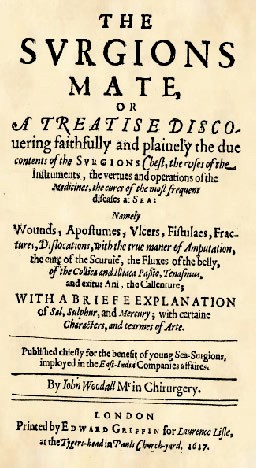
their books, pamphlets and wiles to hawk their products. You will recall the example of physician Adriaan Jean Helvétius and Ipecacuanha discussed on the previous page. He presented his findings on the drug in his book Traite des maladies les plus frequentes et des remedes specifique pour les guerir in 1703 (although this ended the secrecy of the ingredient, the book would have associated the medicine with him, paving the way for continued administration by him).
John Woodall originally wrote his seminal work the surgions mate for the surgeons of the East India Company as "an instruction book to accompany the contents of the medical chest [which Woodall was paid to supply to the EIC], 'with all the particulars thereof, into an order and method.'"10 In 1626, the Barber-Surgeon's Company appointed Woodall to stock medicine chests for the Royal Navy, no doubt due in part to his book and similar duties with the East India Company. So Cockburn was in good company in using his book as a sales tool.
As Cockburn reached the end of his discussion on cures for diarrhea, he started providing the reader with testimonials for his concoction:
The first is a Letter from the Surgeon of the Flamborough at Dublin. The Surgeon, Mr. Rivet, pretended that the Ship's Company was very much afflicted with a Diarrhœa, which must have proved very fatal, but for my Electuary; and therefore desires a Supply of it to be sent him forthwith. I laid his Letter before the Lords of the Admiralty, and their worthy Secretary, Mr. Burchett, ordered him this Supply, which was sent him, which he received, and which was very profitable to him. For Mr. Rivet got above four hundred Pound for the Cures he did in Dublin by four Pounds of my Electuary.3
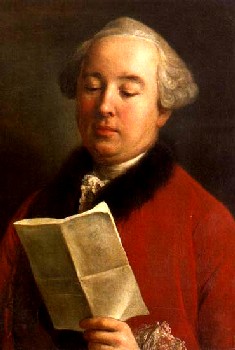
Artist: Pietro Antonio Rortari
Man Reading (Not Cockburn) (1750)
From this letter, it appears that Cockburn was slyly suggesting to naval medical readers that if they were able to get the navy to send them his electuary, they could make a tidy sum treating people in port. It's actually quite clever, so long as the Lords of Admiralty didn't see through the ruse.
Cockburn goes on to give futher naval praise to his cure, including a reference to William Dampier.
Among the rest of those Letters, is one from Mr. Borthwick, wherein he gives an account of the Men cured of Fluxes by the Medicine, and how suddenly they were cured. Then he adds an Observation he had made formerly in Brazil. When, says he, I was at Bahaja de Todos, with Captain Dampier, in her Majesty's Ship the Roebuck, he desired me to visit one Mr. Abraham Jones, Merchant. When I saw him, he was lying a Bed so weak, that he was not able to help himself any Manner of Way. He told me that he had an hundred Stools, and sixty Vomits, in forty eight Hours. His Pulse being very low, I gave him a little Cordial, and some of Doctor Cockburn's anti dyfenterick Electuary, and by the Use of the Electuary, he was so throughly cured in seven Days, that he was able to walk abroad, and was alive when the Woolwich was at Brazil.4
It sounds as if Cockburn is dropping Dampier's name here. However, in a letter dated October 18, 1698, Dampier did indeed ask the secretary for "an allowance of Dr. Cockburn's Electuary against
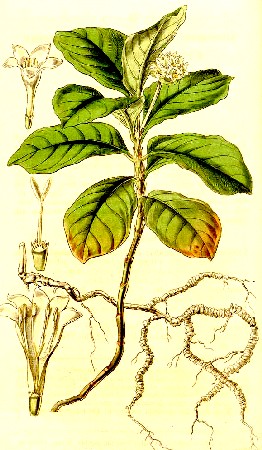
Carapichea Ipecacuanha, from Curtis's
Botanical
Magazine, Vol 70, (1844)
Dysenteries be sent to him in the Downs."5 This was likely done at the behest of Borthwick. Still, mentioning Dampier, a popular figure at the time, might also have been another salesman's tactic - tie his concoction to the renowned adventurer and writer.
Cockburn never revealed the contents of his amazing medicine. Historian Keevil suggests that "it may have contained opium and ipecacuanha." Keevil didn't seem to mind Cockburn's self-promotion of his cure, but he didn't like the fact that "Cockburn condemned the use both of binding medicines and repeated purgation in dysentery, as also the prescribing of ipecacuanha, but these criticisms may have been directed to misleading the medical profession and preventing the discovery of the contents of his secret cure."11
Cockburn spends almost 6 pages of his book on ipecacuanha, offering other writer's opinions in support of it, damning it with faint praise and condemning it. Using the wily salesman's trick of stating the opinion he wants the customer to walk away with at the end, Cockburn finishes with, "Soldiers do not bear it, because it gives them a greater Looseness and carries them off, as it does many among our selves; and consequently it is a medicine the Army will not away with."12
Keevil grouses that the only thing Cockburn "conceded was that it [his medicine] was a form of diascordium Fracastorii, and that 'by proper Changes of its Doses only' it could be used with success in every type of flux. The diascordium was a powerful astringent electuary containing opium and ...Lemnian sealed earth."13 Keevil says that by dismissing ipecacuanha "Cockburn did a disservice to medicine."14 Cockburn might have taught the pirates a few things at that.
1 William Cockburn, The Nature and Cure of Fluxes, p. 161-2; 2 John J. Keevil, Medicine and the Navy 1200-1900: Volume II – 1640-1714, p. 286; 3 Cockburn, p. 167; 3 Cockburn, p. 167-8; 5 William Dampier, Dampier's Voyages, Vol. 2, 1906, edited by John Masefield, p. 329; 6 Charles Crieghton, "Cockburn, William (1669-1739)", Dictionary of National Biography, 1885-1900, Volume 11, wikisource.org, gathered 3/18/13; 7 Keevil, p. 290; 8 Harold J. Cook, "Practical Medicine and the British Armed Forces After the 'Glorious Revolution," Medical History, 1990, 34, p. 23; 9 Crieghton, wikisource; 10 Joan Druett, Rough Medicine: Surgeons at Sea in the Age of Sail, p. 17; 11 Keevil, p. 290; 12 Cockburn, p. 113; 13,14 Keevil, ibid.
Treatment of a Flux: Internal Medicines - Unusual Treatments
One thing you can often depend upon when discussing golden age of piracy era medicines is that there will be some

Photographer: Da Voli
"What? No! The antlers were BAD ENOUGH!"
unusual suggestions. Some of them sound odd to our modern way of thinking. For example, when advising medicines that should be used for a flux, military surgeon Raymund Minderer says, "The Moss that grows on wild Rose-shrubs, reduced to powder, and taken in Wine, wherein have been boiled the husks of Acrons [Acorns], is an approved remedy in this case."1 Since we know that penicillin is of a similar origin, this just seems a trifle strange.
Other medicines sound more distasteful. Minderer also explains that the "dried Liver of a sucking Lamb, or of any other such Animal, is very good in this case, provided such a Liver, before 'tis dried, be boiled in Vinegar. Let the Patient take a drachm. of it twice a day. Also the Blood of a Lamb, or of a Hind, both dried, will have here a good effect."2 While odd, with a bit of witch doctor or Old Testament feel to it, it is not outside the realm of experience. Still, one would hardly want to go about drinking the dried blood of hinds.
Then there are the outrageous things. "The Yard of a Stag helps Fluxes, the bitings of venomous beasts, provokes Urine, and stirs up lust exceedingly."3 Now it's not unheard of to eat the genitals of animals, but as a regular practice to ward off the squirts, it sounds unseemly.
Still, most of the unusual period medicines were just that - unusual. Two rather curious things come up several times in the period literature on fluxes that we will look at in a bit more detail: Crocus Martis - aka. iron oxide - and crayfish.
1 Raymund Minderer, A Body of Military Medicines Experimented, Volume 4 of Paul Barbette's, Thesaurus Chirurgiæ, The Fourth Edition, p. 73; 2 Minderer, p. 74; 3 Nicholas Culpeper, Pharmacopœia Londinesis, p. 46
Treatment of a Flux: Internal Medicines - Unusual Treatments -- Crocus Martis
"The highest Experiment in this case [a flux] is Crocus Martis, taken in the Juyce of the broader kind of Plantain, or in a Pulse of red Beans, or Rice-broath; the dose is half a dram." (Raymund Minderer, A Body of Military Medicines Experimented, Volume 4 of Paul Barbette's, Thesaurus Chirurgiæ, The Fourth Edition, p. 74)
Crocus Martis is basically rust water. To understand how it was made, we have to travel a bit outside the normal medical field into alchemy. Joseph Du Chesne explained the process for making many such metal concoctions in his 1641 book Treatise on Metallic Medicine:
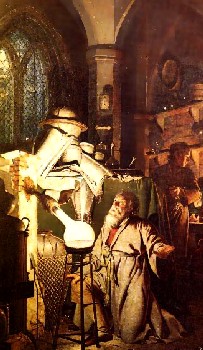
Artist: Joseph Wright of Derby
The Alchemist Discovering
Phosphorus (1771)
Take steel filings or very thin sheets and pour urine or common water on them. In a short time rust will form over the matter. As soon as you see it appear, throw your steel into boiling water which will attract all the rust if you stir the water for some time with your hands, as by such stirring you will separate what is most subtle. Do this several times to remove a good amount of the rust. Now take this materia and put it in a crucible [an open container that can withstand very high temperatures] in a wind furnace, and suddenly your Mars will get red. It will be very easy to dissolve it in an aqua fortis made of 2 parts of vitriol, 1 of common salt, and 2 of bole. If you leave your red steel in this water for 4 or 5 days, it will dissolve completely. If you separate the water from it with the alembic [alchemical still] and raise the fire at the end, your salt will without fail sublimate and, put in a humid place, will turn into a very precious red oil.1
Several of the period pharmacopoeias mention Crocus Martis, but it always seems to be in a mystical and intellectually unsatisfactory way. By the time James Rennie published his pharmacopeia in 1814, the bloom seemed to be off the alchemical rose and he simply referred to crocus martis as 'iron filings,' which he described it as being "tonic and stimulant if taken in substance, and when they meet with an acid in the stomach or bowels, otherwise they are probably inert."2
Nevertheless, in addition to Minderer's glowing comment, Woodall recommends it not once, but twice for treating fluxes. His first suggestion, for diarrheas, is to use "Crocus Martis, or flos Sulphuris [a type of mushroom] being in season adminstred with the conserves of Roses Marmalet"3. He later suggests its again, this time in any sort of flux, noting that "Crocus Martis {1 scruple) given in red wine, Aligant or French wine, or with beere or water for a neede, adding certaine drops of Cynamon water... is a very good medicine."4
1 Joseph Du Chesne, Recueil des plus curieux et rares secrets touchant la medecine metallique, translated by rexsearch.com, gathered 3/19/13; 2 James Rennie, A New Supplement to the Pharmacopœpias of London, Edinburgh, Dublin and Paris, Baldwin and Cradock, p. 154; 3 John Woodall, the surgions mate, p. 207; 4 Woodall, p. 213
Treatment of a Flux: Internal Medicines - Unusual Treatments -- Crayfish

Photographer: PD Photo
Funny looking medicine, isn't it?
Raymund Minder suggests using Crayfish for a flux twice in his book. He first says they are effective in fluxes and looseness, advising they be "boiled in Vinegar, and the scales beaten to powder, taking a drachm of it mornings and evenings, either in red Wine or in Broath wherein in red-hot Steel hath been several times been quenched."1 He later gives another recipe which is even more entertaining (by which I mean horrible to the crayfish). "Burn live Crafishes in an earthen Pipkin [earthen cooking pot] well-closed, until they be so burnt as to be reduced to powder; and of which give to the Patient mornings and evening a Thimble-full or two in a convenient Liquor."2
None of the period pharmacopeia authors have anything whatsoever to say about crayfish, suggesting that perhaps Minderer had wandered a bit too far off the reservation for even them. However, some web research turned up a modern author commenting on their use on behalf of the Institute of Scandinavian and Comparative Folklore. J.-Ö. Swahn explains,
Medical books from the sixteenth century tell us that the juice you get when you crush a living female crayfish in a mortar ...was able to cure ...pain in the heart and in the stomach, epilepsy, venereal diseases, tuberculosis and leucorrhoea, and it was also regarded as an analgesic in general, and as a sudorific.3
So they basically would have served as anodynes according to period understanding.
1 Raymund Minderer, A Body of Military Medicines Experimented, Volume 4 of Paul Barbette's, Thesaurus Chirurgiæ, The Fourth Edition, p. 71; 2 Minderer, p. 75; 3J.-Ö. Swahn,"The Cultural History of Crayfish," Bull. Fr. Pêche Piscic., 2004, gathered from the internet, 3/19/13
Treatment of a Flux: External Medicines
"Here [in the field] is no conveniency of making much use of Apothecary shops; else many things might be prescribed to lay upon the belly and the navil, as also divers fermentations, and stomachical Unguents.
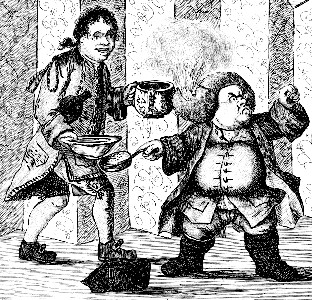
Artist: J. Bretherton
Administering Topicals, The Battle of the Cataplasm (1773)
You may therefore content
your self with those plain and easily parable means, already deliver'd, and be thankful to God for them." (Raymund Minderer, A Body of Military Medicines Experimented, Volume 4 of Paul Barbette's, Thesaurus Chirurgiæ, The Fourth Edition, p. 76-7)
As unusual as it may seem to the modern reader, topical treatments were to be useful for treating patient ill with a flux. Given that plasters were in wide use during this period in history (as well as long before and long after), it is actually not as odd as it might first appear.
Woodall provides a prescription for a 'stomake bag' containing "wormewood, minte, or sweete marjoram, and warme being sprinkled with rose water and vineger, or else a bisket bedued well with rose water and vineger, being steeped, must be applied to the stomake; or annoint the stomake with unguentum pectorale, or with oyle of nutmegs made by expression"1.
We have already discussed the use of wormwood (in absinthe) and nutmeg. While Woodall doesn't specify the type of mint, Nicolas Cockburn advises that water and horse mint plants "Ease pain in the Belly"2 without specifying whether he means internally or externally. He also explains that

Photographer: Giancarlo Dessi, Myrtle Flowers
Marjoram "easeth pains in the Belly" and "helps Fluxes" although here he means when taken internally.3 Culpeper also tells us that different sorts of vinegar were "often, nay most commonly used externally, viz. to bath the place" although he suggests that it was the medicines combined with the vinegar did most of the medicinal work.4 Rose water and was mostly considered cordial5, probably used here more for scent than anything.
For diarrhea, William Cockburn lists the "Plaister of Nævius for the Belly; and it is certain, that Plaisters do more in this and other Diseases, than modern Physicians have lately believed."6 This plaster contains Orizæ torrefactæ [probably torrified rice], mastic, frankincense, Glandium [probably Spiritus Glandium Quercus - a spirit distilled from English oak acorns], myrtle and pine resin"7. Culpeper notes that frankincense "being used outwardly in the way of a Plaister heats and binds."8 Myrtle was thought to be warm and astringent9, although it's inclusion here may have been for scent. James Rennie tells us that pine resin is "stimulant and rubefacient and is employed externally in the form of a plaster"10. John Pechey reckons pine to be good in fluxes.11
1 John Woodall, the surgions mate, p. 203; 2 Nicholas Culpeper, Pharmacopœia Londinesis, p. 32; 3 Culpeper, p.18; 4 Culpeper, p.104; 5 John Pechey, The Compleat Herbal of Physical Plants, p. 159; 6 William Cockburn, The Nature and Cure of Fluxes, p. 131; 7 Cockburn, ibid.; 8 Culpeper, p.74; 9 James Rennie, A New Supplement to the Pharmacopœpias of London, Edinburgh, Dublin and Paris, Baldwin and Cradock, p. 263; 10 Rennie, p. 374; 11 Pechey, p. 149

